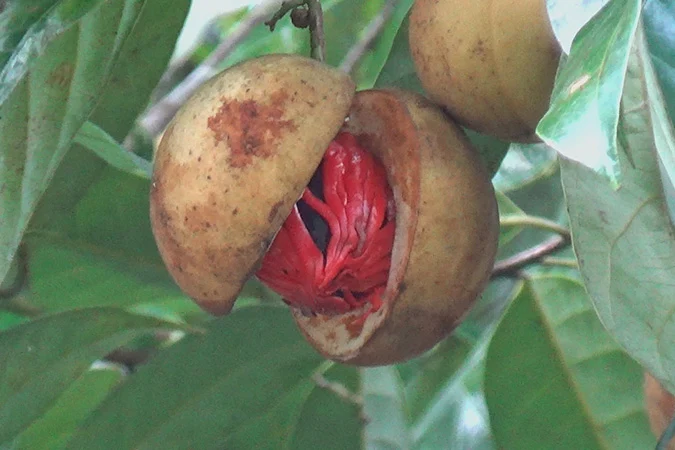Pala or nutmeg (Myristica fragrans) is a plant species in Myristicaceae, an evergreen tree originating from the Banda Islands in Maluku, has a high value as a spice, fruit and seeds and has been an important trading commodity since Roman times.
M. fragrans has a height of 5-20 m or even 30 m in Tidore. The leaves have a 1 cm stalk, arranged alternately, in the shape of a slender ellipse, 5-15 cm long, 2-7 cm wide, a sharp tip, a bone in the middle with many sideways veins, the upper surface is shiny dark green and the lower surface is pale green.
Male and female flowers grow on different trees, although sometimes individuals produce both types of flowers. Bell-shaped flowers, pale yellow and fleshy. Staminates are arranged in groups of up to ten, each 5-7 mm long. The carpels are in smaller groups, one to three and slightly longer up to 10 mm.
Karpelat produces fruit that is ovoid, yellow, smooth, 6-9 cm long and 3.5-5 cm in diameter. The fruit has a fleshy skin and has a distinctive aroma due to the essential oil content. When ripe the rind will split into two parts along the ridge that runs along the fruit.
The fruit that has opened will reveal the seeds. A seed is brownish purple and shiny, 2-3 cm long by about 2 cm wide and has a red covering. Seeds are a great source of nutmeg.
Seeds contain 7-14% essential oil. Powder is used as a flavoring for bread, pudding, sauces, vegetables and refreshments. The oil is also used as a mixture of perfume and soap. Fruit skin for additional mosquito repellent ingredients. The pulp is the basic ingredient for sweets, syrups and candies.
Kingdom: Plantae
Phylum: Tracheophyta
Subphylum: Angiospermae
Class: Magnoliopsida
Order: Magnoliales
Family: Myristicaceae
Genus: Myristica
Species: Myristica fragrans
M. fragrans has a height of 5-20 m or even 30 m in Tidore. The leaves have a 1 cm stalk, arranged alternately, in the shape of a slender ellipse, 5-15 cm long, 2-7 cm wide, a sharp tip, a bone in the middle with many sideways veins, the upper surface is shiny dark green and the lower surface is pale green.
Male and female flowers grow on different trees, although sometimes individuals produce both types of flowers. Bell-shaped flowers, pale yellow and fleshy. Staminates are arranged in groups of up to ten, each 5-7 mm long. The carpels are in smaller groups, one to three and slightly longer up to 10 mm.
Karpelat produces fruit that is ovoid, yellow, smooth, 6-9 cm long and 3.5-5 cm in diameter. The fruit has a fleshy skin and has a distinctive aroma due to the essential oil content. When ripe the rind will split into two parts along the ridge that runs along the fruit.
The fruit that has opened will reveal the seeds. A seed is brownish purple and shiny, 2-3 cm long by about 2 cm wide and has a red covering. Seeds are a great source of nutmeg.
Seeds contain 7-14% essential oil. Powder is used as a flavoring for bread, pudding, sauces, vegetables and refreshments. The oil is also used as a mixture of perfume and soap. Fruit skin for additional mosquito repellent ingredients. The pulp is the basic ingredient for sweets, syrups and candies.
Kingdom: Plantae
Phylum: Tracheophyta
Subphylum: Angiospermae
Class: Magnoliopsida
Order: Magnoliales
Family: Myristicaceae
Genus: Myristica
Species: Myristica fragrans
